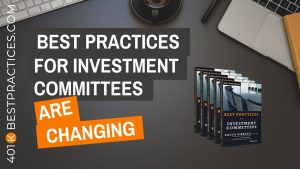 Best Practices For Investment Committees Are Changing
Best Practices For Investment Committees Are Changing
One of my all-time favorite books that I feel all advisors should be familiar with is titled, “Best Practices for Investment Committees” – part of the Wiley Trading Series and distributed by Thornburg Investment Management.
It was one of the first books I read when I started my career in the 401k space and I’ve even given it away on my blog along with a video on how to create training for plan sponsors based on the table of contents.
I typically order 50 to 100 books at a time to give away as part of the Investment Committee Starter Kit as well.
AND I used it as the foundation to create the Best Practices Education Mini-Kit offered here.
The Table of Contents in this book covers key best practices all committees should follow and each concept is explained in detail. Here’s the list of topics covered:
- Chapter 1: Why You Need a 401(k) Investment Committee
- Chapter 2: Forming an investment Committee
- Chapter 3: Investment Committee Meetings
- Chapter 4: Importance of Investment Policy
- Chapter 5: Complying with ERISA Section 404(c)
- Chapter 6: Selecting, Monitoring, and Replacing Investment Managers
- Chapter 7: Employer Stock in the 401(k) Plan
- Chapter 8: Hiring a Pension Consultant
- Chapter 9: Fiduciary Liability Insurance
- Chapter 10: Understanding Investment Expenses & Fees
It’s a Sad, Sad Day…
Today when I called to place another order of 50 books to distribute to advisors and committee members, I was told that Thornburg is no longer publishing this book and it’s no longer available.
This is Bad News and Good News…
On one hand, I need to take down two of my website “freebies” and update one of my template kits that references this book…
On the other hand, I see a great opportunity to rewrite the book and publish it independently with an updated set of “401(k) Plan Management Best Practices” (new title) that plan sponsors need to be following based on current legislation and how plans are managed today.
Here’s the high level outline I’ve created to cover 401(k) Plan Management Best Practices for 2022 and beyond…
- Chapter 1: Understanding ERISA and the Regulations that Govern Retirement Plans
- Including new legislation passed and impacts to operations
- Chapter 2: Understanding Service Provider Roles and Responsibilities
- Chapter 3: What it Means to be a Fiduciary (And How to Limit Fiduciary Liability)
- Chapter 4: Setting Up and Running An Effective Plan Committee
- Chapter 5: Investment Selection and Monitoring (And Why You Might Want an IPS)
- Including QDIA, and ESG Selection and Monitoring
- Chapter 6: Hiring, Monitoring, and Replacing Plan Service Providers
- Including 3(21), 3(38), and 3(16) Selection and Monitoring
- Chapter 7: Participant Communication Requirements
- Chapter 8: Designing Effective Participant Programs (Including Wellness Programs)
- Chapter 9: Avoiding Common Compliance Mistakes
- Chapter 10: Preparing for an Audit (And the Importance of Documentation)
- Chapter 11: Cybersecurity Best Practices
So much has changed over the last 10 years, it was about time for a refresh to include the changing regulations that affect so many of these key plan sponsor topics.
Obviously, there’s a lot to unpack and provide guidance on in each chapter (the devil’s in the details – so are all the new things plan sponsors need to be aware of), but I look forward to the challenge.
Your Thoughts?
What do you think should be included as an essential best practice for plan sponsors today?
Email me and let me know!
Want to contribute to the book with me? Write a chapter? I love crowdsourcing ideas and projects. Just email and let me know – I’m open to suggestions.